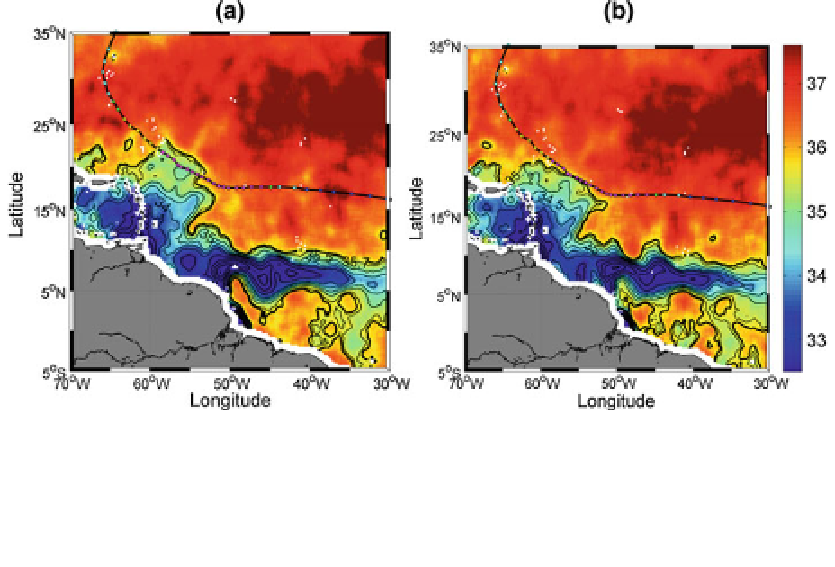Geoscience Reference
In-Depth Information
are hidden just underneath warm plume water. Strong winds from the 300-1,000-km-
diameter cyclonic (counterclockwise) hurricanes might quickly erode a thin plume,
exposing several degrees-cooler NBC ring water to the surface, and potentially contrib-
uting to limit further development of hurricanes. As shown by Ffields (
2007
), the warm
temperatures associated with the low-salinity Amazon-Orinoco River plume and the rel-
atively cool temperatures associated with NBC rings are in close proximity to the passing
hurricanes. As such, they are expected to actively influence the hurricane maintenance and
intensification although the interaction is challenging to accurately quantify.
Vizy and Cook (
2010
) more recently studied the atmospheric response of the sum-
mertime large-scale climate to the Amazon/Orinoco plume sea surface temperature
anomaly forcing using a regional climate model. They performed simulations in the
presence or absence of the Amazon/Orinoco plume SST anomalies. Results from their
simulations indicate that the plume does significantly influence the frequency and intensity
of summertime storm systems over the Atlantic, consistent with Ffield (
2007
). The pres-
ence of the plume increases the average number of Atlantic basin storms per summer by
60 %. An increase in storm intensity also occurs, with a 61 % increase in the number of
storms that reach tropical storm and hurricane strength. Results from their simulations
suggest that Atlantic storms also tend to curve northward further west in the Atlantic basin
in the presence of the plume SST anomaly. These results support the premise that the warm
and low-salinity combined Amazon-Orinoco River plume play an important role in
modulating the air-sea interaction during hurricane passages in a manner similar to per-
sistent freshwater barriers layers.
For instance, when there is a freshwater barrier layer, such as in the northwestern
tropical Atlantic, mixing is restricted within shallower mixed layer and entrainment of cool
thermocline water into the mixed layer is reduced (e.g., Anderson et al.
1996
; Vialard and
Delecluse
1998a
,
b
; Foltz and McPhaden
2009
). As discussed in Price (
2009
), if the net
salinity anomaly (freshwater layer thickness times salinity anomaly in the initial state) is as
Fig. 25 Two SMOS microwave satellite-derived SSS composite images of the Amazon plume region
revealing the SSS conditions a before and b after the passing of Hurricane Igor, a category 4 hurricane that
attained wind speeds of 136 knots in September 2010 during its passage over the plume. Color-coded circles
mark the successive hurricane eye positions. Seven days of data centered on a September 10, 2010 and
b September 22, 2010 have been averaged to construct the SSS images, which are smoothed by a 1 9 1
block average


